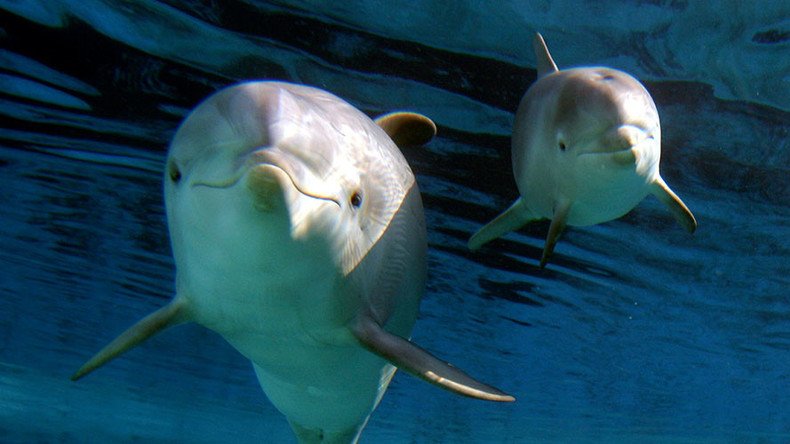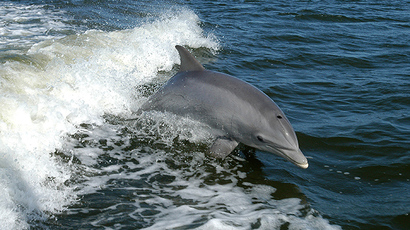BP oil spill linked to baby dolphin deaths and diseases in Gulf Coast

The 2010 Deepwater Horizon spill has been linked to the alarming surge in deaths of stillborn and baby dolphins in the Gulf Coast, according to a new study. They inherited chronic illnesses as their mothers were exposed to oil.
More than 1,400 dolphins and whales have been discovered dead in the Gulf Coast since the BP soil spill began in April 2010, something scientists have termed an “unusual mortality event.” A study last year from the US National Oceanic and Atmospheric Administration (NOAA) directly linked the deaths of many bottlenose dolphins to the effects of the spill, and now a new study has done the same with deceased stillborn and young dolphins.
Published in the journal Diseases of Aquatic Organisms, the study concluded that the reason for many of the deaths was chronic illnesses that the mothers suffered from as a result of the oil spill. It found that 88 percent of all stillborn and baby dolphins that were found in the spill zone had abnormal lungs, including partially or completely collapsed lungs.
Additionally, the small size of the dolphins indicated that their lungs did not fully inflate, and that they either died in the womb or shortly after they were born. In areas not impacted by the spill, just 15 percent of stillborn and baby dolphins suffered from this lung problem.
“Our new findings add to the mounting evidence from peer-reviewed studies that exposure to petroleum compounds following the Deepwater Horizon oil spill severely harmed the reproductive health of dolphins living in the oil spill footprint in the northern Gulf of Mexico,” said Dr. Teri Rowles, co-author of the study and head of NOAA’s Marine Mammal Health and Stranding Response Program, which overseas investigations into these situations.
About 87 percent of the baby dolphins suffered from fetal distress, while 65 percent had some kind of in utero infection.
The BP oil spill affected dolphins directly when the animals came in contact with the plumes, inhaling chemicals that weakened their immune systems and caused “toxic effects,” said Dr. Moby Solangi of the Institute for Marine Mammal Studies, which helped with the study, to WLOX News. Once weakened, the mother dolphins became more susceptible to brucella, which Solangi described as “a bacterium that can cause abortions in livestock.”
Brucella can enter Gulf waters as agricultural runoff from multiple states and Canada, eventually coming into contact with dolphins.
“These results support that from 2011 to 2013, during the northern Gulf of Mexico UME, bottlenose dolphins were particularly susceptible to late-term pregnancy failures and development of in utero infections including brucellosis,” the study reads.
‘Grossly negligent’: Judge approves historic $20 billion settlement for BP oil spillhttps://t.co/127dUDVqcepic.twitter.com/9ihQrg7zJ0
— RT America (@RT_America) April 5, 2016
Last year, another study from NOAA linked the oil spill to dolphin deaths. It found that dolphins had smaller, thinner adrenal glands that had never been seen before in the animals living in the Gulf Coast, and that the smaller glands kept the dolphins from effectively fighting off disease.
“These dolphins had some of the most severe lung lesions that I had ever seen in wild dolphins from throughout the US,” said University of Illinois’s Kathleen Colegrove, who participated in the study, to Reuters in May 2015. “More than 1 in 5 had pneumonia that was severe and caused or contributed to death in those dolphins.”
Alabama governor spends BP oil spill money to renovate beachfront mansionhttps://t.co/F0kSQtlepfpic.twitter.com/jY5SrKwDOT
— RT America (@RT_America) December 30, 2015
The BP oil spill dumped 4.9 billion gallons of oil into the Gulf Coast over five months before it was capped. It may take years to uncover the full extent of the damage on dolphins.
"These animals are slow to mature, so it will take longer for the population to recover to pre-oil spill levels because you've not only seen the loss of adult animals, but the babies, too," said Kathleen Colegrove, a wildlife pathologist with the University of Illinois at Urbana-Campaign's College of Veterinary Medicine, to NOLA.com. "It will take many more years to study the population, to fully understand the effects of the spill."













